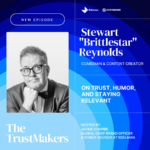By Guillaume Grimbert, VP Business Development, Advertising AI Solutions at Perion
CMOs may have one of the largest technology budgets in the company, but they are not focused on technology. They are focused on transformative growth.
Frustratingly, our industry is fixated on product features and incremental technical advancements in programmatic, data, and AI. Our most popular events, podcasts, and industry publications focus on these minutiae, alienating most CMOs who are looking for creative strategies to build relationships with people and sell products. Few, if any, CMOs attend adtech events.
Rather than create our own arms race, we need to look to brands for inspiration and redesign not only our solutions, but also our dialogue around CMO goals. Technology should be invisible. It should empower creative ideas, not eclipse them. When tech takes center stage, everyone loses: advertisers reduce their ambitions to metrics that don’t matter, agencies become procurement arms, and consumers drown in irrelevant ads that follow them for weeks.
What CMOs Care About
We often see what we want to see. Forrester, Gartner, and McKinsey all focus their CMO surveys on data and technology because they sell consulting. That doesn’t mean the CMO only thinks about data and technology.
The CMO Barometer, a large survey from the University of St. Gallen, Germany finds that the top priority for 2025 is “AI and marketing automation.” However, the survey creators note that the focus is actually on the automation itself and for very specific use cases. These use cases include the ability to deliver compelling experiences for audiences, improve the customer experience and increase ROI.
Here is where our industry fails to see the forest for the trees. The CMO wants to automate elements of their business and use AI to improve workflow, not because they are enamored with the technology itself, but because they want the technology to disappear. The technology is a means to an end, not an end in itself. At ShopTalk Europe, Mark Lallemand of L’Oreal explained that they are investing in AI to transform the way they engage with customers. AI will help them be more relevant by speeding up their creative process, improving testing and reducing overhead costs. At no point did Lallemand focus on the technical details of the AI tools themselves.
Consider these CMO priorities that are often “lost in translation”:
- A CMO wants to reach specific audiences with a new message to capture their attention and make them think about the brand in a new way. Our industry breaks this down into emotionless technical details about audience segments, multichannel optimization and programmatic buying tactics that will maximize outcomes.
- A CMO wants to address their customers’ desire to engage and purchase products more seamlessly. Our industry focuses on dynamic creative optimization, data-driven personalization and curated media buying techniques.
- A CMO wants to build a long term relationship with their audience. Our industry takes advantage of a non-conversion oriented campaign and runs the campaign on low performance, low cost inventory to hit topline CPM and reach goals.
The ad-tech industry offers strong solutions, but too often the focus is misplaced, creating a fractured outcome for CMOs that drifts away from their original goals. Instead of discussing the strategies for creating stable repeating revenue or long-term brand lift, the conversation shifts to mechanics like ads.txt and sellers.json, which are designed to prevent low-quality sites from spoofing media buyers. This narrow focus is how the industry ends up with ads running on MFA sites, CMOs struggling to measure campaign effectiveness across channels, and short-term targets being met at the expense of long-term brand value.
Some of the issue lies in the complex relationship between the CMO, brand teams, media buying agencies, adtech companies and publishers. A broad CMO goal is naturally broken into pieces and handed out to different partners, who don’t always have the big picture to use as a north star for the campaign. We all have our own revenue goals to hit and our own biases. But it’s still just an excuse.
What We Can Give CMOs
We can do better. We all know when we are engaging with an advertiser that they have a larger strategy, a broader goal in mind. Gartner reported that “CMO edge lies in knowing how to synthesize insight from an array of different sources to find opportunities for differentiation.”
CMOs need the pieces to add up. They need insights and data so that they can build the bigger picture and track their progress on their larger goals. The industry is obsessed with mechanics: algorithms, pipes, acronyms. But consumers don’t remember an SSP, a bid request, or a CPM. They remember how a brand made them feel. And the CMO remembers which partners helped them achieve that goal.
Whenever we find ourselves in the technology echo chamber, we should reconsider our approach. These should be the most popular topics in ad-tech:
- Brand strategy: why people choose one brand over another.
- Consumers: what they feel, want, and expect.
- Visibility: the full picture of advertising and marketing effectiveness
- Long-term outcomes: loyalty, equity, demand — not just last-click conversions.
- Tech that disappears: platforms that serve these goals quietly, seamlessly, and without ego.
Somewhere along the way, efficiency became a religion. We’re chasing cheaper impressions, tighter targeting, and micro-optimizations that look good on dashboards but mean nothing to consumers. The result? Brands risk spending more time optimizing the system than building demand for their product or building a brand.











